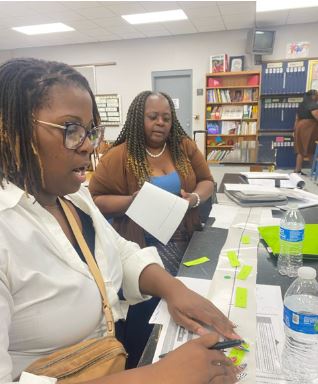As a Title I district, Jackson Public Schools has faced many of the same challenges as most districts educating students living in an urban environment. Our scholars come from all walks of life. Some of our scholars live in stable homes, and some do not. Often, poverty plagues many of our scholars, and this has led to some lacking the strong foundation needed to be proficient in reading and math. Our district has worked relentlessly to provide our scholars with equitable and relevant support to help them achieve success.

An integral component of supporting the growth of our scholars has been a laser-like focus on professional learning and coaching of both our school leaders and teachers. In our district, we have implemented a top-down approach with the idea that everyone needs a coach to help them progress toward excellence. One of our core values is supporting a growth mindset. With well over 20 years in education, mostly in administration, I, too, am continuing to grow and learn how to better lead professional learning to impact the success of all.
Effective video coaching is multifaceted
We started using a video coaching platform from Teaching Channel as part of a federally funded grant project to improve instruction and student achievement. This video coaching platform introduced a different type of coaching to our teachers in nine of our 52 schools. These schools were known as our Project Ignite Schools, which consisted of five elementary schools, three middle schools and one high school. As part of this initiative, teachers uploaded a 10- to 12-minute segment of their instruction for their coach to review and offer feedback.
The feedback portion of the video platform we used provides many benefits in instructional coaching, including the opportunity for coaches to view teachers at their convenience, allowing teachers to observe themselves and reflect more deeply on their own practice, or even helping teachers to see small nuances in their practice — such as speaking primarily to one side of the classroom — that they may miss otherwise.
As we’ve worked to support the growth of our teachers, our students have also shown growth. We noted six key findings as we implemented this approach:
1. Teacher empowerment
Our teachers had the autonomy to decide when they would record themselves and upload to the platform. All they needed to capture the video was their phone. The teachers chose which part of the lesson they needed the most assistance on. For example, we use the gradual release model to support lesson delivery. The teacher might want help with the “we do” part, and would only record that part of the lesson.
After it’s uploaded, their coach offered feedback where needed. Later, the coach and the teacher watch the video together and debrief before coming up with actionable next steps for improvement.
This process allowed the teacher to have shared ownership in his or her own development. Since teachers choose when to make videos and can delete recordings they don’t want to use, they can be sure that they’re receiving feedback on their very best efforts. Teachers can also search the video library of over 1,600 videos to find exemplars to further develop their practice.
2. Focused and brief
We ask teachers to keep their videos short, because if recordings get too long, they lose focus and intensity. By keeping them short, teachers and coaches can focus on a single area to improve. Since it’s less intimidating for educators this way, they typically submit videos more frequently, making for more effective video coaching.
3. Timely and actionable feedback
We encourage our coaches to provide actionable feedback quickly, preferably within 24 hours. Since the clips are short, this isn’t typically a big lift. This ensures that it remains relevant to the teacher and fresh in the mind of the coach. If you wait too long, the coach may need to refresh their memory about what they observed or why they made certain notes.
4. Pilot video coaching with lead teachers
To get buy-in on using video, we had teacher leadership take the plunge first. A lot of teachers were worried about where the videos would go after they made them, who would see them or how they would be used. We kicked off effective video coaching by having our demo teachers make the first videos, helping us begin building a culture of vulnerability.
We also reassured everyone that the videos were not going to be used for evaluations or in any punitive way. As they realized that the process truly was purely for growing teachers, we had more volunteers stepping up to record and share videos.
5. Strategic scheduling
Since we made it voluntary for teachers to record videos, there were times when it became inconsistent. During testing season, for example, our teachers were busy with assessments and reviewing standards. Capturing videos for their coach or professional learning community wasn’t at the top of their minds. To address this, we plan to implement a schedule for video coaching moving forward.
6. Recording tips
If we were starting over with video coaching today, I would begin by providing teachers tips to create quality videos. Our teachers don’t need to be Hollywood cinematographers to capture useful coaching videos, but they do need to be mindful of things like the noise level in the classroom. A video-capturing protocol checklist to ensure proper lighting, orientation of the camera and appropriate sound levels would have yielded more effective video coaching.
We plan to compare outcomes between teachers who have received video coaching and those who have not. Recent research from the Institute of Education Services shows that teachers and students benefit from video coaching and that they’re excited to realize the same benefits. We do know that our students are growing and that our teachers are working together to grow right alongside them.
Kimberly Smith, Ed.D., serves as the executive director of the office of teaching and learning for Jackson Public Schools in Mississippi, where they use Teaching Channel’s ENGAGE Feedback video platform. She can be reached at [email protected].
Opinions expressed by SmartBrief contributors are their own.
_________________________
Subscribe to SmartBrief’s FREE email newsletter to see the latest hot topics on EdTech. It’s among SmartBrief’s more than 250 industry-focused newsletters.
